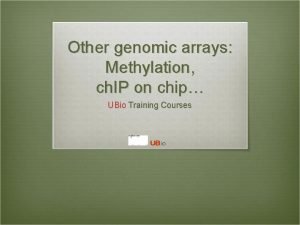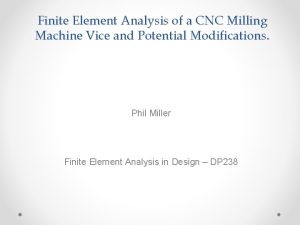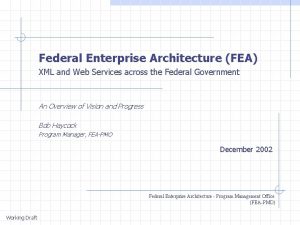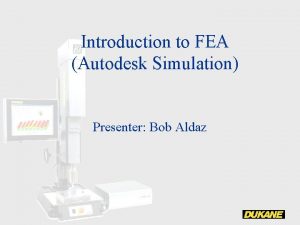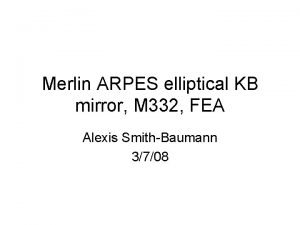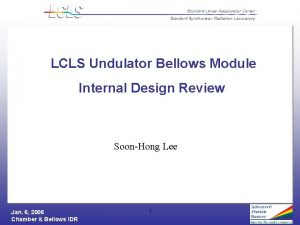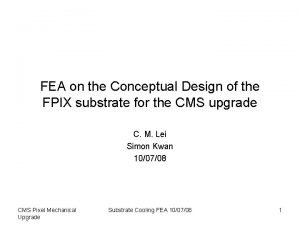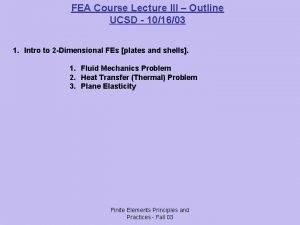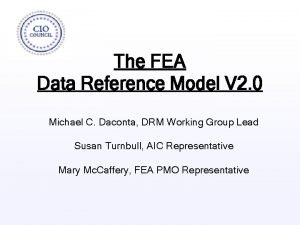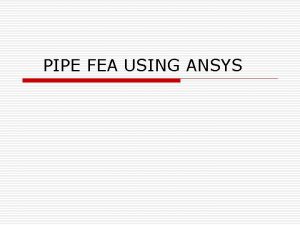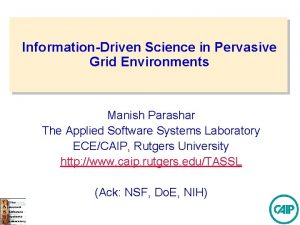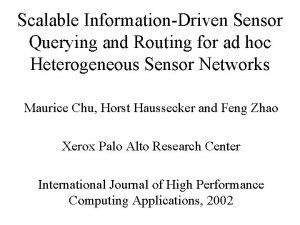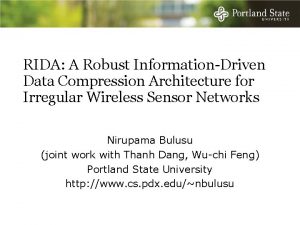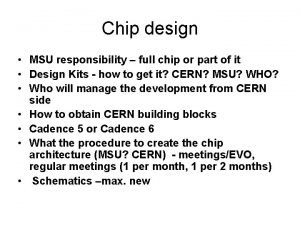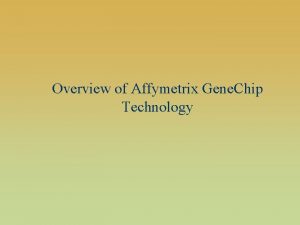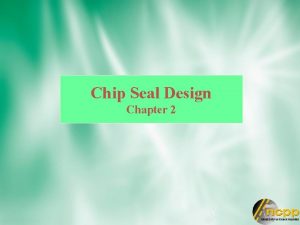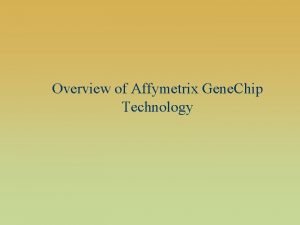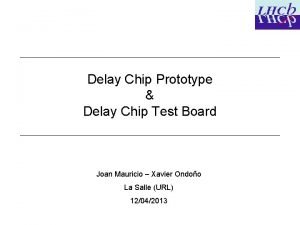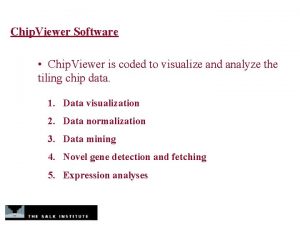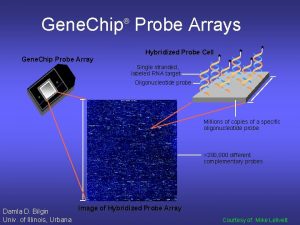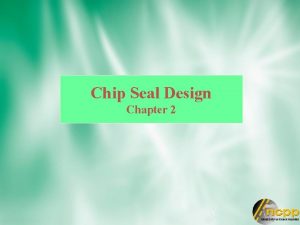An InformationDriven FEA Model Generation Approach for Chip






















- Slides: 22

An Information-Driven FEA Model Generation Approach for Chip Package Applications Sai Zeng 1, Russell Peak 2*, Ryuichi Matsuki 3, Angran Xiao 4, Miyako Wilson 2, Robert E. Fulton 1 1 Engineering Information Systems Lab 2 Manufacturing Research Center 4 Systems Realization Lab Georgia Institute of Technology, Atlanta, GA 30332 -0405, USA 3 Advanced Product Design & Development Division, Shinko Electric Industries Co. , Ltd. , Nagano, Japan 1 23 rd Computers and Information in Engineering Conference September 2– 6, 2003, Chicago, Illinois

Example Chip Package Products Source: www. shinko. co. jp Plastic Ball Grid Array (PBGA) Packages 2 Wafer Level Package (WLP) Quad Flat Packs (QFPs) Glass-to-Metal Seals System-in-Package (SIP)

Variable Topology Multi-Body (VTMB) FEA Meshing Challenges Idealized Analytical Bodies Design Model Decomposed FEA Geometry Models 1 2 3 original Labor-intensive “chopping” 1 2 3 1 a 1 b 2 1 c 3 a 3 b Meshing & Solving 3 c 1 a 1 b 1 c 2 1 d 1 e 3 a 3 b topology change (no body change) 2 3 1 4 3 body change (includes topology change) 1 a 1 b 2 3 1 c 1 d 4 a 4 b 4 c

Traditional Approach l l 4 Small topology changes force mesh model rebuilding from scratch Mesh models are barely reusable using traditional approach FEA Model Planning Sketches in Traditional Approach

Motivation l l l Competition in Chip Package Industry Needs for new technologies and approaches facilitating seamless design and analysis integration Difficulty in analysis model generation – – l Modifications resulting in tedious and time consuming FEA modeling process – – 5 Hundreds of components Variable materials Complex geometric shapes Changeable connectivity configurations – package design analysis discipline idealization

Objective l l l 6 Integrate chip package design using Finite Element Analysis Automate the FEA modeling process to save the modeling time and reduce the human errors Increase reusability of the mesh models during chip package modification and redesign

Frame of Reference – Multi-Representation Architecture (MRA) for CAD-CAE Interoperability l l 7 Composed of four representations (information models) Provides flexible, modular mapping between design & analysis models Creates automated, product-specific analysis modules (CBAMs) Represents design-analysis associativity explicitly

Information-Driven FEA Modeling Approach l l Mapping process ABBΨRMM transforms the ABB model into a readyto-mesh model (RMM) by geometry decomposition. Mapping process RMMΨSMM transforms the RMM into the solvable FEA-based SMM in an automated manner. ABB captures analytical concepts FEA based SMM = object wrapper – – Integrates pre-processor, solver and post processor information Includes vendor-specific script file format T 0 ABB ΨRMM body 1 body 4 body 3 body 2 ABB Model 8 RMM Ψ SMM RMM Model SMM Model Information-Driven FEA Modeling Approach

Analysis Building Block Models (ABBs) l l l 9 An ABB model represents engineering analytical concepts as a set of computable information entities Independent from specific solution techniques Analysis knowledge is captured by employing object-orient information representation technology Information Content for Example ABB Concepts

Analysis Building Block Models (ABBs) l A diving board example is presented to illustrate an ABB system A Graphical View of an ABB System and its Analytical Bodies and Connectivity 10

Ready-to-Mesh Models (RMMs) l l 11 A RMM is obtained by geometric decomposition from a corresponding ABB The geometry of a RMM model is composed of geometry pieces that are convex-shaped and meshable using efficient and cheap meshing techniques. Building blocks of an ABB can be reused to construct a RMM Associativity of building blocks is changed before and after decomposition A Graphical View of an RMM System and its Decomposed Bodies and Connectivity

Decomposition Architecture l l l Decomposition is implemented to obtain conformal mesh along the interfaces of connected bodies Decomposition deals with geometry exclusively Decomposed model consists of decomposed bodies connected along equivalent faces Decomposition Process 12

Decomposition Associativity Mechanism l 13 An mechanism is required to keep track of the information associativity during the geometry decomposition Compositional Relations for Boundary Condition Building Blocks and Continuum Building Blocks after Decomposition

Solution Method Model (SMM) l l 14 It is an information entity that wraps solution tool inputs and outputs into a single logical package SMM includes the SMM information objects and the SMM tool agent

ABB - SMM- Solution Tool Interaction l ABB systems generate SMMs based on solution method considerations – l 15 Via RMMs in these problem types Solution tool capabilities are also usually considered RMM Model

A Chip Package Thermomechanical Analysis Case – An ABB system l l 16 Four linear elastic thermomechanical continua Continua are glued together One rigid pin support Uniform temperature drop as thermal load

A Chip Package Thermomechanical Analysis Case – An RMM l l l 17 A RMM is obtained after automatic decomposition of a ABB system With composition mechanism, information associated with geometry can be assigned on the corresponding decomposed geometry This model can be directly input into the SMM to generate a conformal FEA meshed model

A Chip Package Thermomechanical Analysis Case – An SMM l l l 18 The tool agent translates the model information into the toolspecific computable formats, e. g. a PATRAN command language ASCII file Modeling time is counted as information instance object creation time Modeling time is dramatically reduced comparing to traditional FEA modeling approach

Complex Chip Package Thermomechanical Analysis Case Decomposition ABB Model consisting 182 Input bodies 19 RMM consisting 9056 Decomposed bodies FEA SMM

Closure l l Presentation of information-driven FEA modeling approach Demonstration representing product-independent analysis concepts as knowledge-based objects: – – – l l 20 semantically rich reusable modular and tool-independent Reduction of FEA modeling time (variable topology multi-body application) - reduced from days/hours to hours/minutes Enhancement of knowledge capture and automation level vs. traditional direct FEA modeling approaches

Acknowledgements We are particularly grateful for the support of the following people: – – – 21 Kuniyuki Tanaka, Yukiharu Takeuchi, and Shinichi Wakabayashi of Shinko Electric Ltd. Greg Bettencourt of Shinko Electric America, Inc. Rod Dreisbach of The Boeing Company Mike Dickerson of the NASA Jet Propulsion Lab (JPL) Manas Bajaj, Greg M. Mocko, Edward J. Kim, Injoong Kim at the Engineering Information Systems Lab, Georgia Tech

Question? 22
 Methylation & chip-on-chip microarray platform
Methylation & chip-on-chip microarray platform First generation antipsychotics
First generation antipsychotics Oh lord you are good and your mercy endureth forever
Oh lord you are good and your mercy endureth forever Piececitos gabriela mistral motivo lirico
Piececitos gabriela mistral motivo lirico What is fea
What is fea Fea framework
Fea framework La negrita y el conejo
La negrita y el conejo Robert aldaz
Robert aldaz Alva myrda
Alva myrda Fea
Fea Fea study
Fea study Fem applications
Fem applications Difference between fea and fem
Difference between fea and fem Thefpix
Thefpix Fea course
Fea course Fea reference models
Fea reference models Kontinuitetshantering i praktiken
Kontinuitetshantering i praktiken Typiska novell drag
Typiska novell drag Tack för att ni lyssnade bild
Tack för att ni lyssnade bild Ekologiskt fotavtryck
Ekologiskt fotavtryck Varför kallas perioden 1918-1939 för mellankrigstiden?
Varför kallas perioden 1918-1939 för mellankrigstiden? En lathund för arbete med kontinuitetshantering
En lathund för arbete med kontinuitetshantering Adressändring ideell förening
Adressändring ideell förening
